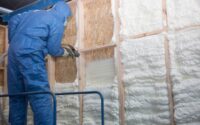Water damage can happen for various reasons, including flooding, burst pipes, or even a leaking roof. When water seeps into your house, it can cause significant damage to your property and belongings. The key to minimizing the damage is to act quickly. But how long can water damage take to dry, and can it be fixed?
This blog post will answer these questions and provide helpful tips for dealing with water damage.
Understanding Water Damage
Water damage is a common issue that homeowners face. It occurs when excess water accumulates in areas where it shouldn’t, causing harm to your property. The longer the water sits in your home, the more damage it can cause.
There are three categories of water damage:
- Clean Water: This type of water comes from rain, melting snow, or a broken pipe. It doesn’t pose any immediate health risks, but if left untreated, it can lead to mold growth and other problems.
- Gray Water: Gray water is slightly contaminated water, usually from sources like washing machines, dishwashers, or sinks. It may contain small amounts of chemicals or bacteria, but it’s less dangerous than black water.
- Black Water: Black water is heavily contaminated from sources like sewage backups or floodwaters. It poses a serious health risk and requires professional help for cleanup, such as these water damage restoration in Lynnwood experts.
How Long Does It Take to Dry Water Damage?
The time it takes to dry water damage depends on several factors, including the extent of the damage, the type of water involved, and the materials affected. On average, it takes about 24-48 hours for water damage to dry. However, it can take up to a week or more if the damage is extensive or proper drying techniques are not used.
Here are some factors that affect the drying time:
- Amount of water: The more water there is, the longer it will take to dry. A small leak may dry within a day, while a flooded room could take several days or weeks to dry completely.
- Type of materials: Different materials absorb water at different rates. For example, wood and drywall can absorb much water and take longer to dry, while tile and concrete dry faster.
- Humidity and temperature: High humidity and low temperatures can slow down the drying process. Ideally, the humidity should be below 60%, and the temperature should be between 70-90 degrees Fahrenheit for effective drying.
- Ventilation: Proper airflow is essential for drying water damage. Opening windows and using fans can help speed up the drying process.
Can Water Damage Be Fixed?
Fortunately, water damage can be fixed if it’s addressed promptly and properly. The sooner you take action, the less damage there will be, and the quicker your home can be restored.
Here are some steps you can take to fix water damage:
- Identify the source: First, find out where the water is coming from and stop the flow if possible. Turn off the water supply to your home if necessary, or call a professional to help you locate and fix the source of the problem.
- Assess the damage: Evaluate the extent of the damage to determine the best course of action. If the damage is extensive or involves black water, it’s best to call a professional property restoration company for help.
- Remove excess water: Use a wet/dry vacuum or towels to remove as much standing water as possible. This will help prevent further damage and mold growth.
- Dry the area: Place fans, dehumidifiers, and heaters in the affected area to promote drying. Open windows and doors if it’s not humid outside to improve ventilation.
- Clean and disinfect: Clean the affected area with an appropriate cleaning solution to remove any dirt, bacteria, or mold. Disinfect surfaces that have come into contact with gray or black water.
- Repair or replace damaged materials: Depending on the extent of the damage, you may need to repair or replace items like flooring, walls, or furniture. In some cases, experts, such as these fire restoration in Bothell professionals, may be needed to address smoke and soot damage caused by fires that resulted from water damage.
- Prevent future water damage: Take steps to prevent water damage in the future, such as maintaining your plumbing system, sealing cracks in your foundation, and keeping gutters clean.
Conclusion
Dealing with water damage can be stressful, but understanding how long it takes to dry and knowing that it can be fixed can provide some relief. The key is to act quickly and seek professional help when necessary. Following the steps outlined in this blog post, you can minimize the damage, speed up the drying process, and restore your home to its original condition.








